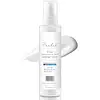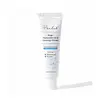What's inside
What's inside
 Key Ingredients
Key Ingredients

 Benefits
Benefits

 Concerns
Concerns

 Ingredients Side-by-side
Ingredients Side-by-side

Water
Skin ConditioningGlycerin
HumectantButylene Glycol
HumectantHydrogenated Polydecene
EmollientEthylhexyl Palmitate
EmollientCetearyl Alcohol
EmollientSodium Hyaluronate
HumectantCynanchum Atratum Extract
Skin ConditioningAllantoin
Skin ConditioningPorphyridium Cruentum Extract
Skin ConditioningCetearyl Olivate
Euphorbia Cerifera Wax
Pullulan
Hydroxypropyl Methylcellulose
Emulsion StabilisingDipotassium Glycyrrhizate
HumectantSodium Polyacryloyldimethyl Taurate
Emulsion StabilisingPolyglyceryl-3 Methylglucose Distearate
EmulsifyingTrideceth-10
CleansingBoswellia Serrata Resin Extract
SmoothingCarbomer
Emulsion StabilisingTromethamine
Buffering1,2-Hexanediol
Skin ConditioningSorbitan Olivate
EmulsifyingDisodium EDTA
Water, Glycerin, Butylene Glycol, Hydrogenated Polydecene, Ethylhexyl Palmitate, Cetearyl Alcohol, Sodium Hyaluronate, Cynanchum Atratum Extract, Allantoin, Porphyridium Cruentum Extract, Cetearyl Olivate, Euphorbia Cerifera Wax, Pullulan, Hydroxypropyl Methylcellulose, Dipotassium Glycyrrhizate, Sodium Polyacryloyldimethyl Taurate, Polyglyceryl-3 Methylglucose Distearate, Trideceth-10, Boswellia Serrata Resin Extract, Carbomer, Tromethamine, 1,2-Hexanediol, Sorbitan Olivate, Disodium EDTA
Water
Skin ConditioningButylene Glycol
HumectantCaprylic/Capric Triglyceride
MaskingGlycerin
HumectantCetearyl Alcohol
EmollientCetearyl Olivate
Limnanthes Alba Seed Oil
Skin ConditioningMangifera Indica Seed Butter
Skin ConditioningSorbitan Olivate
EmulsifyingCynanchum Atratum Extract
Skin ConditioningSodium Hyaluronate
HumectantCamellia Japonica Leaf Extract
Skin ConditioningBeta-Glucan
Skin ConditioningSimmondsia Chinensis Seed Oil
EmollientBetaine
HumectantHydrolyzed Hyaluronic Acid
HumectantSodium Acetylated Hyaluronate
HumectantIsododecane
EmollientSodium Polyacryloyldimethyl Taurate
Emulsion StabilisingXanthan Gum
EmulsifyingTrideceth-10
CleansingEuphorbia Cerifera Wax
Boswellia Serrata Resin Extract
Smoothing1,2-Hexanediol
Skin ConditioningHydrogenated Polydecene
EmollientDimethicone/Vinyl Dimethicone Crosspolymer
Skin ConditioningDisodium EDTA
Ethylhexylglycerin
Skin ConditioningDimethicone
EmollientWater, Butylene Glycol, Caprylic/Capric Triglyceride, Glycerin, Cetearyl Alcohol, Cetearyl Olivate, Limnanthes Alba Seed Oil, Mangifera Indica Seed Butter, Sorbitan Olivate, Cynanchum Atratum Extract, Sodium Hyaluronate, Camellia Japonica Leaf Extract, Beta-Glucan, Simmondsia Chinensis Seed Oil, Betaine, Hydrolyzed Hyaluronic Acid, Sodium Acetylated Hyaluronate, Isododecane, Sodium Polyacryloyldimethyl Taurate, Xanthan Gum, Trideceth-10, Euphorbia Cerifera Wax, Boswellia Serrata Resin Extract, 1,2-Hexanediol, Hydrogenated Polydecene, Dimethicone/Vinyl Dimethicone Crosspolymer, Disodium EDTA, Ethylhexylglycerin, Dimethicone
Ingredients Explained
These ingredients are found in both products.
Ingredients higher up in an ingredient list are typically present in a larger amount.
1,2-Hexanediol is a synthetic liquid and another multi-functional powerhouse.
It is a:
- Humectant, drawing moisture into the skin
- Emollient, helping to soften skin
- Solvent, dispersing and stabilizing formulas
- Preservative booster, enhancing the antimicrobial activity of other preservatives
We don't have a description for Boswellia Serrata Resin Extract yet.
Butylene Glycol (or BG) is used within cosmetic products for a few different reasons:
Overall, Butylene Glycol is a safe and well-rounded ingredient that works well with other ingredients.
Though this ingredient works well with most skin types, some people with sensitive skin may experience a reaction such as allergic rashes, closed comedones, or itchiness.
Learn more about Butylene GlycolCetearyl alcohol is a mixture of two fatty alcohols: cetyl alcohol and stearyl alcohol. It is mainly used as an emulsifier. Emulsifiers help prevent the separation of oils and products. Due to its composition, it can also be used to thicken a product or help create foam.
Cetearyl alcohol is an emollient. Emollients help soothe and hydrate the skin by trapping moisture.
Studies show Cetearyl alcohol is non-toxic and non-irritating. The FDA allows products labeled "alcohol-free" to have fatty alcohols.
This ingredient is usually derived from plant oils such as palm, vegetable, or coconut oils. There is debate on whether this ingredient will cause acne.
Due to the fatty acid base, this ingredient may not be Malassezia folliculitis safe.
Learn more about Cetearyl AlcoholCetearyl Olivate is an emulsifier and texture enhancer. It is derived from the fatty acids of olive oil and Cetearyl alcohol, and is biodegradable.
As an emulsifier, it is used to prevent oils and waters from separating. It can also
Manufacturers use the name Olivem 1000. This ingredient has been found to preserve the natural microbiome of skin. Having a healthy microbiome helps keep our skin healthy and protects against harmful bacteria. This ingredient is grouped with Sorbitan Olivate under the name Olivem 1000.
Learn more about Cetearyl OlivateWe don't have a description for Cynanchum Atratum Extract yet.
Disodium EDTA plays a role in making products more stable by aiding other preservatives.
It is a chelating agent, meaning it neutralizes metal ions that may be found in a product.
Disodium EDTA is a salt of edetic acid and is found to be safe in cosmetic ingredients.
Learn more about Disodium EDTAGlycerin is already naturally found in your skin. It helps moisturize and protect your skin.
A study from 2016 found glycerin to be more effective as a humectant than AHAs and hyaluronic acid.
As a humectant, it helps the skin stay hydrated by pulling moisture to your skin. The low molecular weight of glycerin allows it to pull moisture into the deeper layers of your skin.
Hydrated skin improves your skin barrier; Your skin barrier helps protect against irritants and bacteria.
Glycerin has also been found to have antimicrobial and antiviral properties. Due to these properties, glycerin is often used in wound and burn treatments.
In cosmetics, glycerin is usually derived from plants such as soybean or palm. However, it can also be sourced from animals, such as tallow or animal fat.
This ingredient is organic, colorless, odorless, and non-toxic.
Glycerin is the name for this ingredient in American English. British English uses Glycerol/Glycerine.
Learn more about GlycerinHydrogenated Polydecene is an emollient. It creates a non-occlusive film on the skin that offers extra protection for your skin barrier.
The texture of Hydrogenated Polydecene ranges from light and silky to rich.
Hydrogenated Polydecene is the end compound of controlled hydrogenation of Polydecene.
Learn more about Hydrogenated PolydeceneSodium Hyaluronate is hyaluronic acid's salt form. It is commonly derived from the sodium salt of hyaluronic acid.
Like hyaluronic acid, it is great at holding water and acts as a humectant. This makes it a great skin hydrating ingredient.
Sodium Hyaluronate is naturally occurring in our bodies and is mostly found in eye fluid and joints.
These are some other common types of Hyaluronic Acid:
Learn more about Sodium HyaluronateSodium Polyacryloyldimethyl Taurate is a polymer and used to help stabilize other ingredients.
Emulsion stabilizers hold ingredients together, helping to create an even texture throughout the product.
Sodium Polyacryloyldimethyl Taurate can also be used to thicken the texture.
Learn more about Sodium Polyacryloyldimethyl TaurateSorbitan Olivate is created from the fatty acids in olive oil and sorbitol.
This ingredient is an oil in water emulsifier. It helps stabilize a product by preventing oils and waters from separating. Sorbitan Olivate also helps hydrate the skin.
Manufacturers sell sorbitan olivate under the name OliveM 1000. OliveM 1000 a multifunctional ingredient. It is self-emulsifying. According to a manufacturer, OliveM 1000 does not disrupt natural skin biome.
Due to its olive oil base, this ingredient may not be fungal-acne safe.
Learn more about Sorbitan OlivateWe don't have a description for Trideceth-10 yet.
Water. It's the most common cosmetic ingredient of all. You'll usually see it at the top of ingredient lists, meaning that it makes up the largest part of the product.
So why is it so popular? Water most often acts as a solvent - this means that it helps dissolve other ingredients into the formulation.
You'll also recognize water as that liquid we all need to stay alive. If you see this, drink a glass of water. Stay hydrated!
Learn more about WaterEuphorbia Cerifera wax comes from a shrub in Northern Mexico. It is used to stabilize formulations and has emollient properties.
Emollients form a thin layer on top of skin to prevent water from evaporating, keeping skin and lips hydrated.
According to a manufacturer, this wax can range from a yellow/brown color to translucent.
Learn more about Euphorbia Cerifera Wax